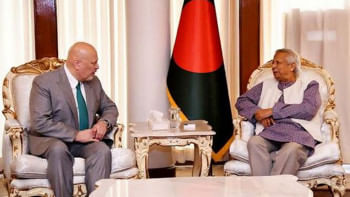Of plants & healing

Naznin Akhter Nipa's garden in Katianangla, in Khulna's Batiaghata upazila, is full of weird and wonderful plants. Some, like pineapple, hydrangea, basil, neem, tulsi, asparagus and aloe may be familiar. Others have names that sound altogether otherworldly, even menacing: Indian snakeroot, devil's cotton, devil's trumpet, skunkvine... What all 2,000 species of the 50,000 featured plants have in common are their healing properties. Nipa's is a one-acre nursery of medicinal plants.
“My husband was a small trader and he used to catch fish,” Nipa recalls, “But one day pirates looted his trawler and took his nets. We faced ruin. We were raising two daughters and I had to find a way out of such perilous economic circumstances. Then a local NGO suggested I could run a nursery and at first I planted vegetables around the house.”
Nipa wasn't satisfied. “Many people grow vegetables and general nurseries too are common in our area,” she says. “I wanted to do something outstanding, something that would enchant people. So, in 2000 I started to plant medicinal saplings instead.”
Nipa went from place to place, eager to collect new medicinal species, while her husband Ayub Ali was busy selling leaves, bark and roots as each harvest was achieved. He also collected books. “I bought 81 books so far, some of them very rare, about treating human ailments with medicinal herbs,” Ayub says.
“I want to increase community knowledge about disease prevention and cure using herbs,” Nipa remarks. “Most people don't know the names of plant species or what medical properties they have.” Nipa searched for specific plants among roadside bushes; her husband travelled to various districts of India to purchase rare specimens for high prices. As news of her garden spread, medicinal plant enthusiasts sought her out too, offering yet more species for her collection.

Nowadays, Nipa earns up to Tk 25,000 per month from her garden and she advises other local women in horticulture. From her exotic plants Nipa has become well-known across Khulna, earning the moniker “Herbal Mother.” More importantly, the family is solvent.
“Everyone in society should follow her example,” says Batiaghata's Upazila Nirbahi Officer Md Bellal Hossain.
“Her medicinal garden is not only an asset for our upazila but for the whole country. Demand for the medicinal ingredients she supplies is rising, day by day. To encourage her I had a tube well installed nearby and paved the road to her home with bricks for better access.”
“Many women in her locality have stepped forward,” says the upazila's agriculture officer Rubayet Ara. “Inspired by her, they too wish to establish herbal gardens. I hope to continue cooperating with Nipa and her neighbours, as her pioneering efforts have the potential to improve the economic outlook of the whole community.”
“Many of the plants Nipa grows were almost extinct,” says Nirependranath Bairagi, vice-principal of Khulna Unani Medical College. “For our practitioners such ingredients were increasingly difficult to source. Nipa has changed that.”

“As there is demand for medicinal plants,” Nipa says, “more people should cultivate them. I hope to grow these plants for the rest of my life and to disseminate knowledge of how to use them. I will help anybody to start their own garden. Even growing the plants is medicinal in a way: all the different fragrances themselves work as a kind of inhaler!”
Indeed, one who looks set to follow in her footsteps is her elder daughter Zinia Akhter Nim, currently a student of Khulna Unani Medical College. “Once I have completed my study I hope to expand the garden and take it up as my profession too,” she says.
Nipa is pleased with her daughter's ambition. “All women should engage in income-generating activity,” she advises, “They should stand on their own feet and achieve economic self-sufficiency.”



 For all latest news, follow The Daily Star's Google News channel.
For all latest news, follow The Daily Star's Google News channel. 



Comments